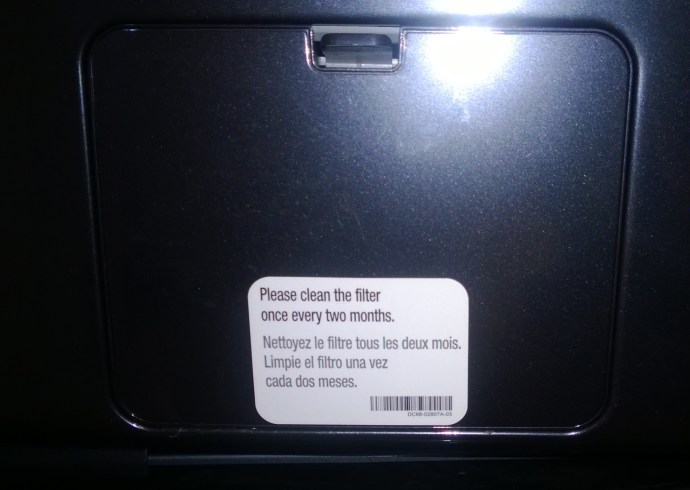Or Why Samsung Engineers Must Not Do Laundry
One of the fastest moving trends is that of ubiquitous computing or the “Internet of Things.” It’s a pretty exciting time and you’ve probably noticed from my presentations that I’m pretty jazzed about the opportunities that the Internet of Things represents.
In the middle of last year, our 15 year old washer and drier were getting so noisy that they were almost calling out to be replaced. While we thought our previous laundry pair was futuristic with the stain brain touchscreen, we didn’t realize how much the world has changed. In addition to the larger capacities, energy efficiency ratings and great new functions, the technologies that they employ have advanced to make the chore of doing laundry as easy as it possibly can be. So when we looked at replacing our noisy pair, getting units with touch screen controls was a high priority. Samsung had just what we were looking for with a pair that uses touch screen controls. These machines even have WiFi connections so that you can control them from your smartphone. Sadly, they still don’t collect your laundry, sort, fill the washer nor fold it when it done. That said, they are pretty good at getting your clothes clean. Until… Until I noticed this little sticker on the front of the washer.
 “Please clean the filter once every two months” – OK, I guess I better do that. With two Bernese Mountain Dogs and gals with long hair, the last thing I want is a hairball gumming up the works. There’s a little round plug behind this little door that you turn and pull out. So I got out a 10 inch bowl, placed it in the drawer underneath the plug and removed the cylindrical filter. Gosh, water went everywhere. In the bowl, in the drawer, along the bottom sill and ultimately on the floor. I quickly cleaned the filter screen, replaced the plug and got the paper towels. I dried the drawer, dried the floor and everything else that got wet. And I dried it again, and again and again. Who had that great idea? Open a filter and soak your laundry room with the water that’s left after you’re done washing a load. While I was prepared with a large container, how many people would think of that? But the water doesn’t come out evenly. It flows everywhere. Now an engineer that occasionally does laundry might realize that they might want to direct the water someplace. They might realize that even if the water goes everywhere, it might be an idea to have the water collected in the plastic drawer stay there and not flow out and under the appliances. It leads me to believe that the engineers who worked on the filter had never actually used it and experienced the mess that results. Samsung engineers must not do laundry.
“Please clean the filter once every two months” – OK, I guess I better do that. With two Bernese Mountain Dogs and gals with long hair, the last thing I want is a hairball gumming up the works. There’s a little round plug behind this little door that you turn and pull out. So I got out a 10 inch bowl, placed it in the drawer underneath the plug and removed the cylindrical filter. Gosh, water went everywhere. In the bowl, in the drawer, along the bottom sill and ultimately on the floor. I quickly cleaned the filter screen, replaced the plug and got the paper towels. I dried the drawer, dried the floor and everything else that got wet. And I dried it again, and again and again. Who had that great idea? Open a filter and soak your laundry room with the water that’s left after you’re done washing a load. While I was prepared with a large container, how many people would think of that? But the water doesn’t come out evenly. It flows everywhere. Now an engineer that occasionally does laundry might realize that they might want to direct the water someplace. They might realize that even if the water goes everywhere, it might be an idea to have the water collected in the plastic drawer stay there and not flow out and under the appliances. It leads me to believe that the engineers who worked on the filter had never actually used it and experienced the mess that results. Samsung engineers must not do laundry.
It leads me to the mission statement that I have on my blog: “Using technology in the right place, in the right way at the right time.” I’m reminded of the electric drill that inspired my engineering journey. You see, this drill has a little red LED that would blink when you were getting the energy boost to power through and finish boring that hole. Living in Canada and doing my fair share of renovations in the freezing cold, I was reminded that when I am using a drill in -40 temperatures, I simply want it to drill that hole. I want the drill to work after it falls off the ladder for the third time. It struck me that the LED and the energy boost were features that really didn’t add anything useful to this power tool and might actually take away some of the expected utility.
The messy filter serves as a reminder to engineers and designers everywhere. It reminds them to remember the primary purpose of the thing that they are working on. The coffee maker needs to be a coffee maker first and be connected second. The refrigerator should probably keep food cold before it tweets the status of the eggs. The light bulb might need to illuminate the room in addition to having its colour adjusted from your smartphone. As we seize the opportunities though the internet of things, let’s make sure we remember the primary purpose of those items we’re working with and make them better by connecting them.

































